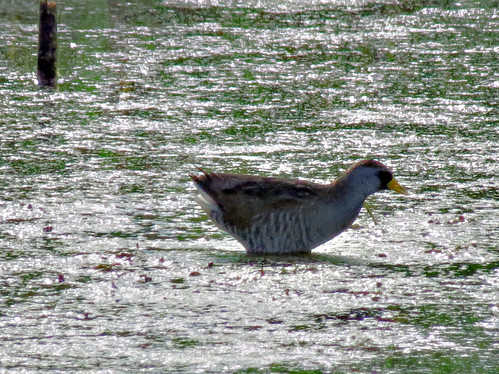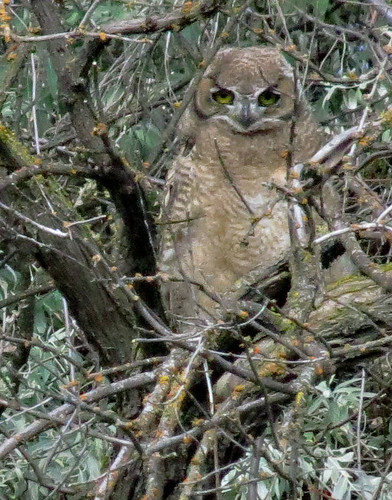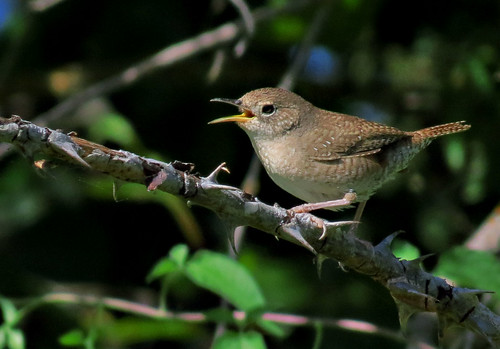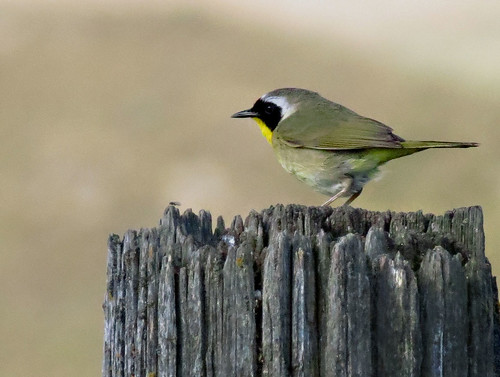I thought I'd share some of my Sunday activity with you. There are three of us assigned to work on Sundays at the Visitor Center, but two of us are plenty. So our boss lets one of us drive around the refuge. We can start as early as we want and only have to show up in time to relieve the others for lunch. I wasn't supposed to drive, but the automatic car used by the volunteers has to go to the shop. I share the truck I'm assigned with them, but it is a standard. Both the guys are learning to drive standard but the on-duty driver wasn't comfortable driving on our hilly route. So he offered the drive to me.
WOW! TWO Sundays in a row to play. Last Sunday I ended up spending two hours with eight bighorned sheep. This Sunday, I hardly saw any wildlife, even though I had left at 6:30A. M. So I ended up back in the headquarters area by 8:45 A.M.
I decided to spend a little time checking out the birds. The first ones I found were the yellow-headed blackbirds. The I found two young sora's. One of their parents remained hidden, but gave its loud call which is described sounding like a canyon wren on steroids. But the babies were just giving a one-note alarm call. I got both their pictures but had to shoot almost directly into the sun. Then I was able to catch one of several common yellowthroats sitting on a fence post with the sun on him.
Then, as I was driving down the road, I thought about our owl fledglings and looked to see if I could see them. I saw one brown blob, which turned out to be one of the babies, when I looked through my binoculars. I drove down the street by the bunkhouse and found four baby western kingbirds. We also have lots of Eastern Kingbirds but I didn't notice any babies.
But Monday, as I was walking up to close the gates, I noticed three eastern kingbirds on the fence across the road. As soon as I started walking on the road, one of them dive-bombed me. So I think those two left sitting on the fence were babies. Their future white fronts are still a little grey.
I copied and pasted the following directly from my eBird record I turned in Sunday.
Entering multiple trips to your own favorite areas really fills out the life histories of each of the species of birds found there. This data helps give ever more accurate arrival and departure dates and can help us find out which species are being impacted by global warming. We can also see how a changing habitat is effecting the different species of birds.
And as an interesting side note: I met a lady who works in the Houston, Texas zoo. She is helping to raise Attwater Prairie Chickens for release back into their habitat. For an interesting video on the effort to save this species, click here. I have a very soft spot in my heart for these birds because the hardest volunteer job I've ever done was to spend a morning beating tall grass with a net to catch the grasshoppers. I think I only collected two or three gallons of bugs. That year, there were eleven hatches and each mom and babies ate a two-gallon container of bugs every two hours during the day. So it's a tremendous job to catch enough bugs for all the new babies.
And after all that hard work, I got to leave early and didn't have to close - my least favorite job on the refuge. A very good Sunday.
WOW! TWO Sundays in a row to play. Last Sunday I ended up spending two hours with eight bighorned sheep. This Sunday, I hardly saw any wildlife, even though I had left at 6:30A. M. So I ended up back in the headquarters area by 8:45 A.M.
I decided to spend a little time checking out the birds. The first ones I found were the yellow-headed blackbirds. The I found two young sora's. One of their parents remained hidden, but gave its loud call which is described sounding like a canyon wren on steroids. But the babies were just giving a one-note alarm call. I got both their pictures but had to shoot almost directly into the sun. Then I was able to catch one of several common yellowthroats sitting on a fence post with the sun on him.
Then, as I was driving down the road, I thought about our owl fledglings and looked to see if I could see them. I saw one brown blob, which turned out to be one of the babies, when I looked through my binoculars. I drove down the street by the bunkhouse and found four baby western kingbirds. We also have lots of Eastern Kingbirds but I didn't notice any babies.
But Monday, as I was walking up to close the gates, I noticed three eastern kingbirds on the fence across the road. As soon as I started walking on the road, one of them dive-bombed me. So I think those two left sitting on the fence were babies. Their future white fronts are still a little grey.
I copied and pasted the following directly from my eBird record I turned in Sunday.
Location
Natinal Bison Range Day Use Area, Lake County, Montana, US
Date and Effort
Sun Jul 14, 2013 8:45 AM
- Protocol:
- Traveling
- Party Size:
- 1
- Duration:
- 2 hour(s), 15 minute(s)
- Distance:
- 0.5 mile(s)
- Observers:
- Marilyn Kircus
- Comments:
- N/A
Species
29 species (+1 other taxa) total
And here are a few more pictures from my birding time. Sometimes I get a little distracted by other creatures or plants.
 |
| A young teasel seed pod in the making |
 |
| Yellow-headed blackbird |
 |
| Cabbage white on huckleberry bloom |
I decided to share my eBird record with you for a couple of reasons. One, I spent a lot of time entering my data and wondered if I could open the record up, copy and paste it and not have to re-upload the pictures I included. That answer is Yes. And I didn't have to retype any part of the record, either.
The other reason is to encourage you to share all your sightings through eBird. If, when you travel and stop to visit a location, just keep the records of what you saw there that day. Don't keep one list for several locations. This date is VERY valuable and each little piece is helping us understand the locations where species are flourishing or in trouble. Researchers looking for species of concern use the data to figure out where to find the species they want to study.
You have a great way to keep your own records and locate them at any time and from anywhere you can access the Internet. And with a smart phone, you can can enter your birds as you find them, in the field and don't need to carry a separate notebook and paper. Another asset is that your data is filtered by a sort of mechanical filter. It will ask you are if you are sure you saw a species or saw the numbers you reported. Then a human will check again and sometimes ask you for more details of what you saw or for pictures. Then, if you made a mistake and entered the wrong species, he will help you figure out what species you actually saw. This is a great learning tool for me and might also help you identify birds.
Entering multiple trips to your own favorite areas really fills out the life histories of each of the species of birds found there. This data helps give ever more accurate arrival and departure dates and can help us find out which species are being impacted by global warming. We can also see how a changing habitat is effecting the different species of birds.
After you upload your pictures - Flickr is perhaps the easiest now - you can just copy/paste the link to that picture. (I asked Google how to insert a picture in eBirds and the directions popped right up.)
And as an interesting side note: I met a lady who works in the Houston, Texas zoo. She is helping to raise Attwater Prairie Chickens for release back into their habitat. For an interesting video on the effort to save this species, click here. I have a very soft spot in my heart for these birds because the hardest volunteer job I've ever done was to spend a morning beating tall grass with a net to catch the grasshoppers. I think I only collected two or three gallons of bugs. That year, there were eleven hatches and each mom and babies ate a two-gallon container of bugs every two hours during the day. So it's a tremendous job to catch enough bugs for all the new babies.
And after all that hard work, I got to leave early and didn't have to close - my least favorite job on the refuge. A very good Sunday.






Your bird photos are wonderful! I'm assuming you have a camera and are not taking those with a cell phone?
ReplyDeleteThanks, too, for the update on eBird. I haven't used it at all - I love to bird but haven't done any organized birding in years, so I haven't kept in the loop about electronic tools that I should be using. I'll check it out.
Thanks. You just paid me in full for writing this blog. Using eBird is definitely a win/win situation for the birds and for us.
DeleteYou also might want to check out the birding apps for your smart phone or Kindle Fire. Get the picture AND song right in the field, and don't need a milk carton of guides.
Yes, I use a camera - a Canon Powershot SX40 which has an equivalent of a 500 mm zoom. The SX50 has the equivalent of an 800 mm, I believe. This is small enough to haul everywhere, cheap enough to risk loosing and makes plenty good enough pictures for sharing via the Internet.
Sounds like another most excellent day on the range.
ReplyDeleteYep, almost as good as today when I've suddenly been put in charge of finding all our fire extinguishers and getting them to the guy re-certifying them. So far, only 7 missing out of 64. And am just about ready to go collect the finished ones and deliver them back to their mounts. This is my day off so I only have a few jobs to do. :)
Delete